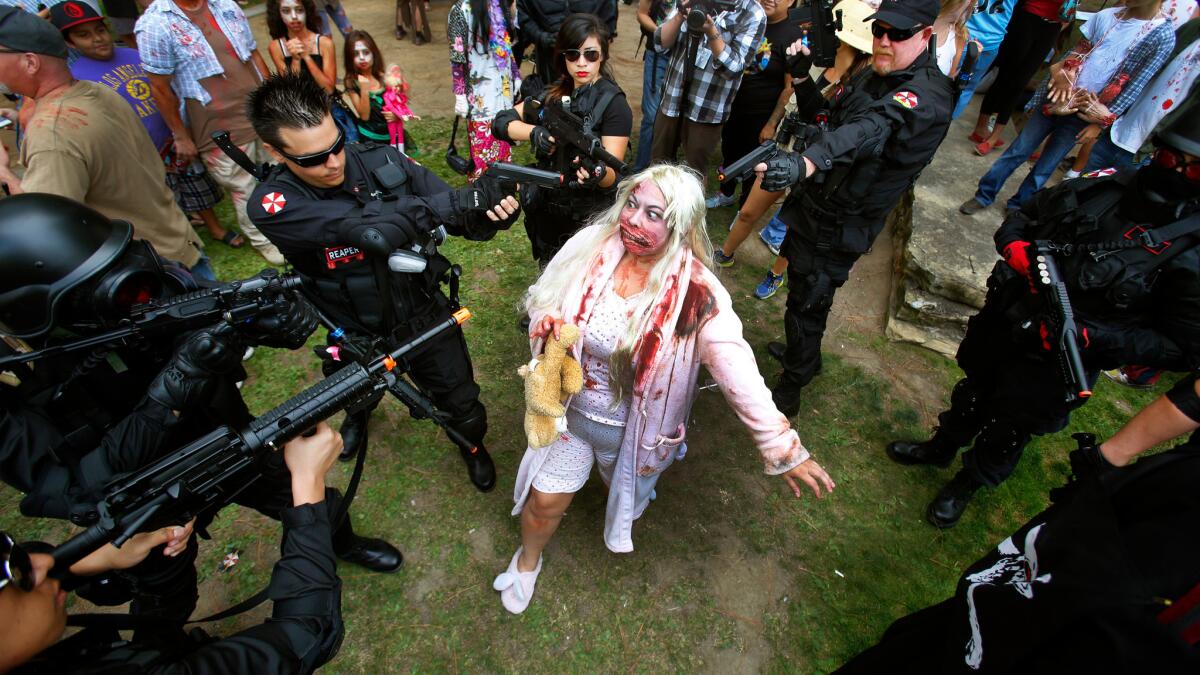Security at Comic-Con 2016: Keeping the mayhem make-believe

- Share via
Comic-Con International 2016 begins this week, ushering an expected 135,000 people into the San Diego Convention Center and nearby hotels and venues for four days (plus preview nights) of panel discussions, screenings, sneak peeks, autograph signings, exclusive announcements and more. It’s a pretty friendly crowd, authorities say, but bringing that many people together in one spot for any reason creates security concerns.
This year, following a run of deadly attacks in public spaces, those concerns may be heightened — and while an event like the Republican National Convention can simply prohibit things like toy water guns, Comic-Con gatherings thrive on the presence of playful weaponry and masks.
“With terrorism across the globe — France last year — and Dallas and Orlando, you have to make adjustments,” said San Diego Police Department spokesman Lt. Paul Connelly.
“While we don’t discuss specifics of security at Comic-Con, we have a great relationship and work very closely with the San Diego Police Department and other law enforcement officials,” said David Glanzer, chief communications and strategy officer for the event.
MUST-SEE PANELS AT 2016 SAN DIEGO COMIC-CON | Read more »
In addition to what the event described as a “great many hired security staff,” including some from outside the area, there is an onsite police command post at the Convention Center during the event, and a security management company coordinates efforts. Security-related discussions are held “routinely” during the year leading up to each convention.
The Police Department coordinates with event planners also to determine the number of police officers and traffic controllers needed and works with the San Diego Harbor Police, the Naval Training Center and even the FBI in addition to event security when something the size of Comic-Con International comes to town, Connelly said. There are 50 hotels in the Comic-Con room block this year, Glanzer said.
Cosplay — in which fans don sometimes-elaborate costumes and take on character identities as part of the convention experience — presents its own challenges.
When you’re having a good time and you’re in costume, even something as simple as crossing the street can be dangerous.
— San Diego Police Dept. Lt. Paul Connelly
No “functional props or weapons” are allowed, though simulated and costume weapons can be, the event’s website says. There’s a costume props desk where cosplayers must go to have their gear inspected and tagged.
It’s not exactly routine TSA-style territory.
Some unique specifics: Costume swords must be tied down so they can’t be drawn, arrows must be zip-tied to a quiver with the tips removed, and costumes with stilts must be approved. If a venue is really crowded, a person in an oversize costume might be asked to leave, the website says.
In recent years, several Comic-Con-related incidents have made headlines: In 2010, a fight between two men in their 20s over seating for a panel discussion featuring Seth Rogen ended with one man being taken out of Hall H in cuffs and the other being wheeled out in a stretcher after allegedly getting stabbed near the eye with something resembling a pen.
In 2014, police responded after a 17-year-old cosplayer from Riverside was found in the middle of the night, unconscious and injured by the pool of a hotel in the area.
And in 2015, what would have been the 10th incarnation of the Zombie Walk — a rowdy, unofficial event in which costumed convention-goers wander nearby streets in character — was canceled after an incident the year before where a 64-year-old woman who was taking pictures during the 2014 walk was hit by a car and suffered what authorities described as serious arm injuries.
This year, a revived Zombie Walk is scheduled to start at 6 p.m. Saturday with the same security guidelines in place as in previous years, according to the group’s Facebook page. Among those guidelines: Drugs, alcohol and weapons are not permitted, and participants are asked to obey all traffic laws.
“That event’s not sanctioned by the Police Department,” Connelly said. “But through social media channels, people plan these things and we generally find out about the time and location at the last minute.” The department’s special-events team then has to hustle to make sure traffic keeps flowing and participants and others are safe, he said.
In general, he said, even as the numbers have multiplied over the years, people coming to participate in Comic-Con are “a very friendly crowd. They’re here to have a good time, they’re respectful. Ninety-nine percent of the time they do what we ask them to do, and they’re glad to see us and want us to protect them.”
Police mostly want them to be aware of their surroundings and alert police if help is needed, Connelly said.
“When you’re having a good time and you’re in costume, even something as simple as crossing the street can be dangerous, if you forget to look both ways.”
Plus — there are zombies out there.
ALSO:
Meet Jeff Walker, the man who brought Hollywood to Comic-Con
Inside the world of fan filmmaking, where lovers of ‘Star Wars’ and ‘Star Trek’ play
‘Gods’ and ‘Squads’ will fight for the attention of the masses at San Diego Comic-Con 2016
Follow Christie D’Zurilla on Twitter @theCDZ.
More to Read
The biggest entertainment stories
Get our big stories about Hollywood, film, television, music, arts, culture and more right in your inbox as soon as they publish.
You may occasionally receive promotional content from the Los Angeles Times.











